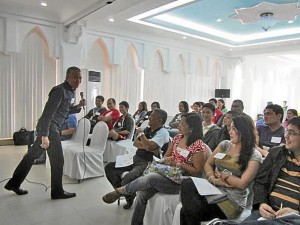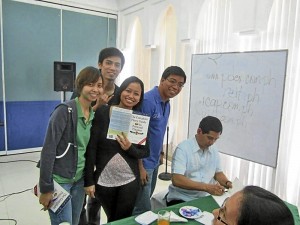With the increasing prices of basic commodities and tons of expenses due each month, budgeting the monthly salary is becoming more and more difficult these days. Many employees, whether they are earning enough or not, are not spared from this scenario.
Holcim Philippines, the country’s biggest cement manufacturer, recognizes this dilemma and has initiated a values and financial management program that aims to help its employees manage their personal finances well. What makes it unique is the involvement of employees’ family members in the seminar.
“It’s not just the person taking responsibility. It recognizes that the person has the support system which is the family and that support system has to live up to its name – become a support system – so that whatever goals that they decide on would be achieved. It has to be the entire family working together,” explains Beng V. Prado, Holcim’s vice president for corporate communications.
Prado shares that although the company has touched on these topics in many of their in-house seminars before, this is the first time that it’s being offered as a formal course.
Higher rates
“I think the decision to go into something specifically devoted to this was, first, the hard times. We all went to the difficult times in the recent years … when we benchmarked, we know we offer higher than average rates in the industry, but we still recognize that a lot of our employees still have a hard time especially those in the provinces,” adds Prado, noting that employees who are heavily indebted choose to do more overtime work to augment their earnings.
“But it’s not healthy for them because they need to rest and be able to balance,” Prado laments.
PARTICIPANTS listen to the lecture on values-based financial management.
Although Holcim encourages its employees to maintain a 40 percent net take home pay, Prado says “there are employees who have much difficulty keeping this intact kasi marami silang utang … so the take home pay in itself maliit na and soon after ubos kaagad when they reach home. We really felt that the circumstances warranted a program like this.”
The two-day seminar had its initial run at the company’s Davao plant last year and has since been an ongoing program of the company. “It is an investment for our employees’ future,” Prado says.
The workshop is conducted by the Personal Finance Advisers Philippines headed by Efren Cruz, author of “Pwede Na! The Complete Pinoy Guide to Personal Finance.” Seminar attendees are given a copy of the book for free.
Prado says the facilitators adapted the course in the Philippine setting making it more understandable to the participants.
One important aspect being discussed in the family values session is “valuing the work of the spouse.”
Prado says their employees in the provinces are more pressured because their families expect a lot from them since they are working in a big company.
“But the family has no idea how hard the work of the wife or the husband is. So we brought the spouses to our plants for them to see how difficult it is to work there … you know, our kiln is very hot so pinagpapawisan talaga yung mga workers. So in the seminar, it is emphasized that every little thing you enjoy, especially if you’re not working yourself, is the result of the hard work of your spouse. That’s very important because ’pag alam mo na pinaghirapan, somehow you take care of it,” Prado explains.
Holcim employees have their personal finance books signed by author Efren Cruz
Financial issues
The second part of the seminar deals with the skills portion and helps participants understand financial issues like budgeting, investing and saving up their money. Although many Filipinos don’t have the savings mindset, Prado says it is important to save not only during hard times but more so during good times.
“If you’re talking about savings mas kailangan mo mag-save when you have the leeway,” Prado says.
At the end of the workshop participants have a one-on-one consultation with the facilitators who teach them action planning and guide them on how to reach their savings or retirement objective.
Holcim employees attest to the importance of the values-based financial seminar:
Karyn Young, 25, attended the seminar with her mom. She says she is grateful that the company is providing educational seminars like this to its employees.
Although she and her family have always been “matipid [thrifty],” she admits that she used to splurge a little on magazines, shoes, etc.
“One thing I learned from the seminar is to buy things that I need rather than the things I want,” shares Young, single, who works as a customer care representative.
She adds that she needs to prioritize because she also helps her parents in the household expenses.
Young also admits having difficulty in managing several credit cards. “It hit me that most of my money is spent paying credit card bills.” Now she only has one credit card which she uses only in case of emergency.
She particularly enjoyed the session on how to compute their net worth. She says it got her to thinking about how she is saving enough for the future. The workshop also helped her to consider investing on mutual funds.
Eunee Ann Gelano, on the other hand, brought along her husband to the seminar. Although both of them are working, they want to know where best to invest their money for their two kids’ future.
Gelano admits that she used to be an impulsive buyer but the seminar taught her how to better handle their finances, and showed her the importance of having long-term or performing assets aside from savings.
Gelano says the workshop gave her and her husband a clearer vision of how they’re going to start making their finances grow—bond funds, and a business venture that her husband is planning to pursue in the future.
Alex Gutierrez, an HR assistant, was still single when he attended the seminar last year, but was saving up for his then upcoming wedding.
Now two months married and a dad-to-be, Gutierrez appreciates the lessons he learned from the workshop.
“I learned that you should have a specific savings for a specific purpose, for example, for car maintenance, for the baby, etc.” Although they’re still adjusting to married life, he says his wife knows how to save and budget their finances especially in preparation for the new addition to the family.
Gutierrez admits that when he was still single, he’d buy anything he wanted and would save only what’s left, instead of setting aside savings first. “But now I can allocate and manage our finances better.”



